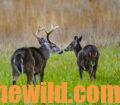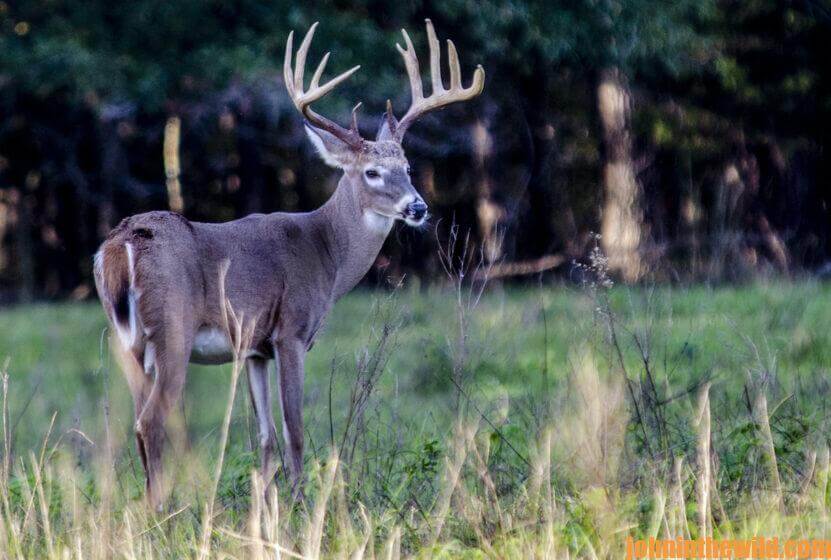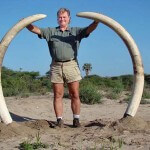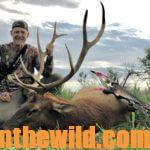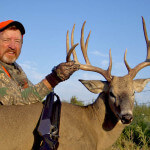Editor’s Note: Between the cover where deer bed down, and the places where they feed, big bucks are on the move and more vulnerable then.
 The first glow of day was beginning to wipe away the black smoke of darkness, as I sat shivering in my tree stand. The brown thrush was one of the first woodland creatures to awaken. He labored through the leaves – trying to make a living scratching out worms and grubs in the decaying foliage. A few squirrels bounded along the limbs and caused heavy dewdrops to fall that resembled miniature showers.
The first glow of day was beginning to wipe away the black smoke of darkness, as I sat shivering in my tree stand. The brown thrush was one of the first woodland creatures to awaken. He labored through the leaves – trying to make a living scratching out worms and grubs in the decaying foliage. A few squirrels bounded along the limbs and caused heavy dewdrops to fall that resembled miniature showers.

As the sun cautiously peeped over the horizon, I noticed an erratic movement 30-yards away. While sitting motionless, I saw the twitch again and recognized the white hair inside a deer’s ear. The deer was feeding behind a blackberry thicket. All I could see was that one ear. Within 15 minutes, the doe had fed around the thicket and was in plain view, some 20-yards away. But she wasn’t the only deer I could see. Two yearling bucks and three more does moved through the acorn flat I was watching. Carefully I raised my favorite .30-06 Mannlicher rifle (https://www.steyr-arms.com/) and scoped the deer. Any one of them would have been an easy shot, however, a big buck was my quarry. So, I let these deer pass.
Another uneventful hour passed. I wondered if my hunting companion knew what he was talking about when he’d said, “Deer usually pass through this bottom in the mornings after they’ve been feeding on the soybeans all night. Then at daylight, they move out of the fields through this bottom and on into their bedding sites – a few hundred yards into the woods. Your best chance of taking a good buck should be in this bottom, which is a transition area between bedding and feeding places.”
Transitional regions are choice locations for bagging bucks for several reasons.
- A hunter won’t spook deer as easily moving to the transition areas as he will when he hunts feeding places or bedding sites.
- Well-defined, easy-to-locate trails usually are in transition areas.
- The deer will be moving more in transition areas than in bedding or feeding sites.
- Trail cameras can give you the time, the date, the weather conditions and the wind conditions to more accurately predict when a buck has been crossing a transition area. This information is more accurate than trying to guess when he will feed or bed. My favorite trail camera is a 30 megapixel 16.9 inch wide screen Stealth Cam (https://www.stealthcam.com/) that operates on 8 AA batteries with an SD memory slot up to 512GB and gives time, date, moon phase and temperature.
 To locate an active transition area, a hunter must first find the buck’s preferred food source and the direction he travels from the food to thick cover or bedding locations. This chore is relatively easy, if deer are feeding on agricultural crops or green fields.
To locate an active transition area, a hunter must first find the buck’s preferred food source and the direction he travels from the food to thick cover or bedding locations. This chore is relatively easy, if deer are feeding on agricultural crops or green fields.
Once a hunter observes deer in a field, he should notice:
- from which direction the deer leave the field;
- what trails are leading to and from the field;
- where cover is that a deer is using to bed; and
- where the best place along the trail are to make a blind or take a stand by following that path.
If deer are feeding on acorns or shrubs, the hunter should pinpoint the highest concentrations of deer sign – trails, tracks, droppings, half-eaten acorns or chewed shrubs – and follow the trails from these places to the cover or bedding sites of deer.
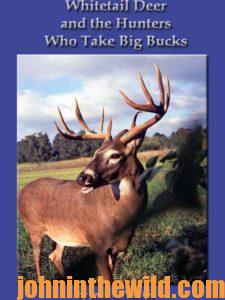 To learn more about hunting deer, check out John E. Phillips’ book, “Whitetail Deer and the Hunters Who Take Big Bucks,” available in Kindle, print versions and Audible at http://amzn.to/2bYwYOK. You may have to copy and paste this link into your browser. (When you click on this book, notice on the left where Amazon says you can read 10% of this book for free and hear 10% for free). On the right side of the page and below the offer for a free Audible trial, you can click on Buy the Audible book. To see more of John’s deer books, visit www.amazon.com/author/johnephillips.
To learn more about hunting deer, check out John E. Phillips’ book, “Whitetail Deer and the Hunters Who Take Big Bucks,” available in Kindle, print versions and Audible at http://amzn.to/2bYwYOK. You may have to copy and paste this link into your browser. (When you click on this book, notice on the left where Amazon says you can read 10% of this book for free and hear 10% for free). On the right side of the page and below the offer for a free Audible trial, you can click on Buy the Audible book. To see more of John’s deer books, visit www.amazon.com/author/johnephillips.
Tomorrow: Find Scrapes to Locate Deer


